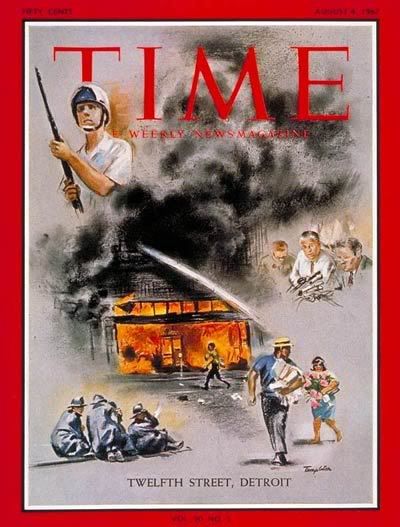You had to be there to understand what happened. Imagine, it was cold, dark and smoky; the surrounding lighting wasn't what it is today. Anger was everywhere, there had already been two days of violence, and shots fired the day before.
Across the country violence was erupting, in small cities and large.
Beginning with the Rochester 1964 race riot, the nation witnessed numerous riots in major cities. By 1967, the mainstream civil rights movement preaching "non-violent" civil disobedience lead by Dr. King was in decline, replaced by a wave of the high-profile and often violent Black Power Movement along with its more militant approach to combating racism.

The 12th Street Riot in Detroit which began in the early morning hours of Sunday, July 23, 1967 lasted five days and before the end there were forty-three dead, including several white store owners, firemen and one police officer. Of 467 injured, nearly half were Detroit police officers or Detroit firefighters. The riot was prominently featured in the news media, with live television coverage, and extensive newspaper reporting.
New Jersey suffered through six days of rioting, ending less than five days before the beginning of the Detroit riot. Toledo, Chicago, St Louis, and Atlanta had all seen their share of violence and death by December 31, 1967.
So late on the cold night of February 8, 1968 South Carolina State Patrolmen were well aware of what could happen when mob violence took control of a protest gathering.
Without clear orders, fearful for their own safety after being attacked with debris and seeing one of their own severely wounded, in the confusion of the moment with apparent close in gun fire they responded.
It is doubtful these patrolmen fired their weapons in anger or with malice.
The tragic killing of 3 unarmed students, was simply a culmination of the events of the past year which had been portrayed vividly on live television, night after night.
Visions of violence and death elsewhere combined with the lack of situational awareness, the violence and gun fire of the prior night, while being confronted with an unseen but expected enemy, led them to fire in self defense of perceived armed attackers.
They were neither “trigger happy” or angry, simply scared to death as you would have been had you lived in America in 1968.
No comments:
Post a Comment